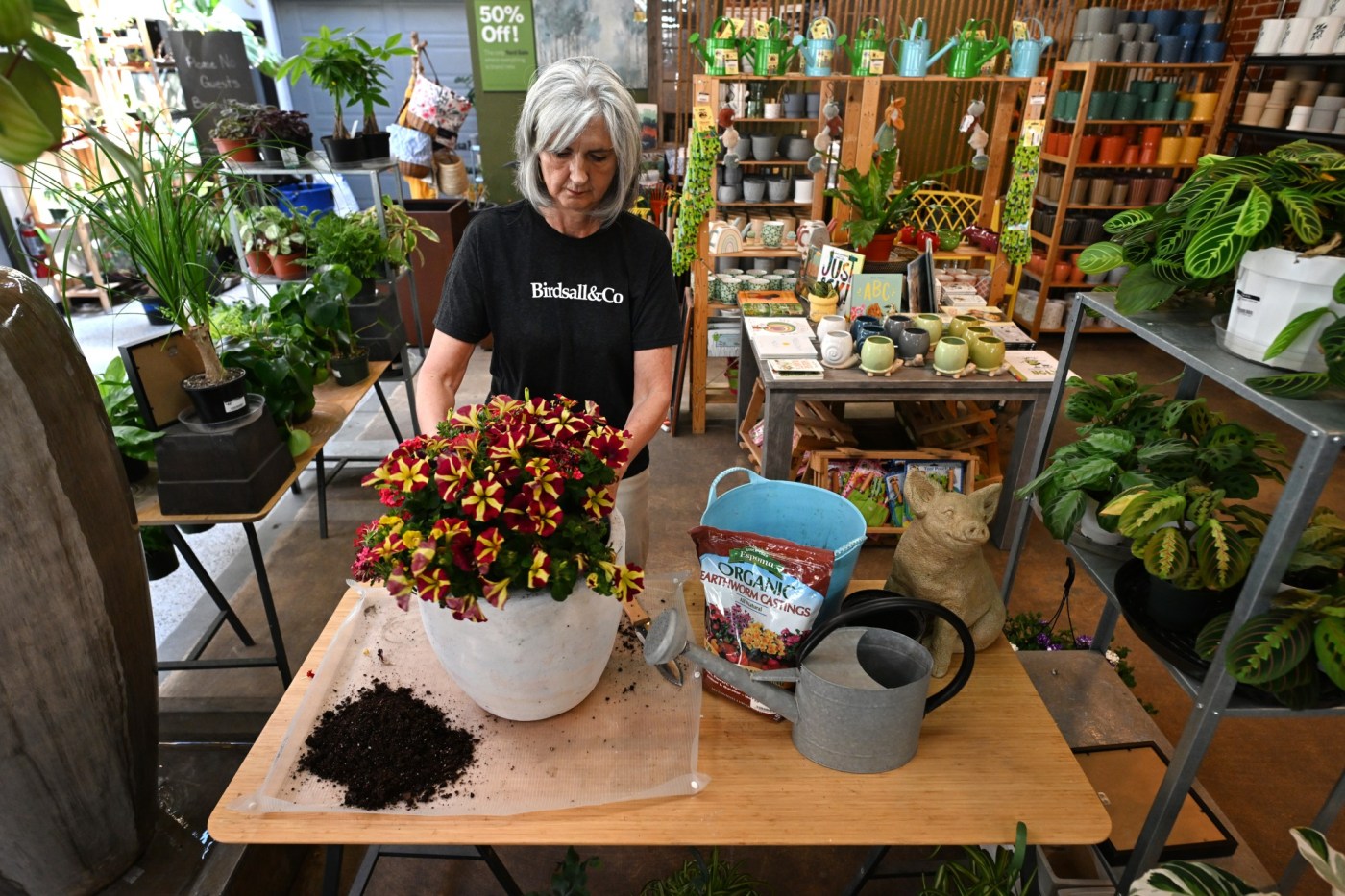
Garden variety: Containers are the perfect way to add color to your porch, patio and lawn
Container gardens offer instant gratification to those who want to enjoy flowers and plants all summer long. Fill a pot with soil, pick your plants and voila! The payoff comes in having a beautiful garden to enjoy.
Gardens in a pot are perfect for those who crave variety. “You can change things every year and through the seasons,” says Annie Huston, co-owner of Denver boutique Birdsall & Co. and a longtime garden designer. A mixture of eye-popping annual flowers might suit you one spring, while a mix of tropical plants and succulents might be to your liking the next. And when summer turns to fall, you can replace plants with new ones to transition into the cooler months.
With so many choices, where do you begin? We asked Huston to break down the process.
Annie Huston, owner of Birdsall & Co., right, shows a collection of flowering plants that make for good container gardens at Birdsall & Co in Englewood, Colorado on April 24, 2024. In the photo Huston is holding from left to right clockwise a Super Moon red zonal geranium, left, a Main Street Oxford Street coleus, and a Star Dust Super Flash grassleaf spurge, right. (Photo by Helen H. Richardson/The Denver Post)
Sun or shade
One of the first things to determine is whether the pot will be mostly in sun or shade, because some plants will wither and die if exposed to too much sun, and others won’t thrive without it.
Huston says that if your container will get western exposure or strong southern sun for most of the day, pick plants that will do best in sun. Containers receiving eastern or northern sun, very filtered sun, or those located under a roof or trees will do best with shade-loving plants. A sun-loving annual will not die in shade or part shade, but it will not produce the expected color or bloom.
Pick your pot
Bigger is better when you are making a container garden as smaller pots dry out quickly. “A collection of smaller containers makes the plantings less interesting and more difficult to maintain,” Huston says. “The idea when choosing containers is to imagine them in the winter months when they are empty of lush colors. They should make a statement on their own, although no pot should ever be empty.”
The size of the container is dictated by the space and scale of the location. While bigger pots make more of a statement, they can be heavy and hard to move when filled with soil and plant material. Huston’s trick for filling them is to invert plastic pots with drain holes and place them inside the larger pot so you’ll need to use less soil overall.
The material of the container -– stone, terra cotta, glazed ceramic, synthetic materials -– doesn’t make a big difference as long as the right soil is used and the plants get enough water, Huston says.
Cast stone containers tend to be more formal and best used for a home’s front entrance or on a large pool deck. “Because of their weight, they need to be placed in a permanent location and become part of the architecture of the house,” she says.
Annie Huston, owner of Birdsall & Co., shows some of the hundreds of pots available at her store that make for good container gardens at Birdsall & Co in Englewood, Colorado on April 24, 2024. (Photo by Helen H. Richardson/The Denver Post)
Huston is a fan of terra cotta and glazed containers because they are available in a variety of styles, textures, colors and shapes to enhance and complement the architectural style of the home and garden.
Lightweight containers are popular for rooftop terraces or balconies and allow for very large sizes without the cumbersome weight. Using plant caddies with wheels can make pots easy to move around depending on weather and light requirements.
Related Articles
Sealing homes’ leaky HVAC systems is a sneaky good climate solution
How to get maximalist decor on a minimal budget
How to get maximalist decor on a minimal budget
Whatever type of pot you use, make sure it has a drainage hole in the bottom.
Select the right soil, plants
Garden centers offer a variety of types of soil mixes for containers. Huston likes Espoma organic potting mix, which includes earthworm castings, alfalfa meal, kelp meal, feather meal and a proprietary blend of mycorrhizae (fungi that have a symbiotic relationship with plant roots).
A ficus tineke, or rubber fig, the larger plant in the arrangement, helps make for an interesting arrangement with other plants in a large container that would be suitable to grow in shady location at Birdsall & Co in Englewood, Colorado on April 24, 2024. (Photo by Helen H. Richardson/The Denver Post)
There are scores of plant options for full-sun containers, so select colors, colors, textures and growth patterns that appeal to your eye, Huston says. The plant tags are an easy way to determine which plants will do well in the sun.
“You cannot go wrong with grasses, verbenas, lantanas and the old-fashioned but reliable geraniums,” she says, adding, “Canna lilies come in different sizes and are perfect for a centerpiece.”
For shade containers, “nothing beats impatiens for a splash of color,” Huston says. Coleus, begonias and upright fuchsias are other choices.
Design considerations
Those just starting out with container gardening can make things easy by choosing two to three varieties of plants with the same growth pattern and let them intertwine for a natural look. “Simple and healthy is better than a mixture of random plants picked at the garden center because they looked lovely that day,” Huston says.
Have patience as some plants will not look their best until they are given room to grow. Examples include euphorbia, sweet alyssum, verbena, creeping Jenny and calibrachoa.
While mixtures of plants are enticing, there’s also nothing wrong with using a single plant type, she says. “The maintenance is simplified and the results striking.”
Keep in mind that instead of relying on colorful flowers to provide the container’s eye appeal, a plant’s leaves can make the statement. “Foliage interest in all its variations and hues looks gorgeous when paired with a dash of contrasting bloom appearing between the leaves,” Huston says.
Consider mixing indoor plants with annuals. “It’s not only surprising and sophisticated, it is also recycling when you bring them inside after the season,” she says. “Succulents make for wonderful full-sun containers when accompanied with blooming annuals.”
The appeal of succulents is their “enormous personality, their drought-resistant nature and sculptural forms.” Her favorite is the red yucca “shining by itself in a full sun container, and when it flowers, it attracts hummingbirds.” Others she likes outdoors in the summer and indoors in winter are large agaves, Mexican grass tree, and “the beautiful aloe for its structure, soft green and sunburn relief.”
A variegated dwarf smooth agave plant, the larger plant in the arrangement, helps make for an interesting arrangement with other plants in a large container at Birdsall & Co in Englewood, Colorado on April 24, 2024. (Photo by Helen H. Richardson/The Denver Post)
Containers can be made with edible plants as well as ornamental ones. “Some vegetables have the most luscious leaves and give a tropical feel to the design. Kale, artichoke, and broccoli are just a few of them,” she says.
Herbs should be used in full sun to “enchant us with their fragrance,” the garden designer says. Use basil, sage and lavender as centerpieces in a container, and plant strawberries and nasturtium on the edges where they can trail.
You can also incorporate perennials into containers. For sunny spots, add gaura, a long-blooming perennial that adds feathery lightness, and coral bells for foliage interest. For shade containers, hostas and Japanese forest grasses are great choices. When summer ends, you can plant the perennials in your outdoor landscape.
Water and fertilize
Once you’ve invested the time and resources to select and plant your containers, keep them healthy by fertilizing and watering. Huston recommends applying a liquid fertilizer that contains fish and seaweed every couple of weeks.
For watering, if there is an irrigation system in the landscape near your containers, spaghetti tubing is easy to insert through the drainage hole.
Hand water early in the morning or evening when temperatures aren’t too high. In the hottest part of the summer, most containers need water daily. Watering the edges of the containers, under the grown leaves, is an important detail since these plants are more prone to drying out.
The French-born Huston calls her approach “watering with Champagne,” finding it relaxing to hold a watering wand in one hand and a beverage of choice in the other while taking a daily stroll among the plants to be watered.
Suzanne S. Brown is a freelance writer and the former features editor at The Denver Post.
More plants to try
ZZ Raven zamiaculca zamiafolla, in front, is a plant that is good for container gardens at Birdsall & Co in Englewood, Colorado on April 24, 2024. (Photo by Helen H. Richardson/The Denver Post)
Shade: ZZ plant (Zamioculcas zamifolia); snake plant (Sansevieria laurentii); begonia escargot; mistral orange begonia; spider plant (Chlorophytum comosum); wandering Jew (Tradescandia zebrina); creeping Jenny (Lysimachia nummularia)
Sun: red geranium; white lantana; rosemary; verbena lanai white or deep purple; calibrachoa cabrio yellow; petunia sanguna yellow
A how-to class
Birdsall is hosting a container planting party on May 19, from 10 a.m. to 3 p.m. Bring an empty 15- to 18-inch diameter (measured at the top) container from home, or purchase a new one at the store for 20% off the day of the workshop. Birdsall will provide the soil, plants, instruction, design advice, and help loading your container. The shade container workshop is 10 a.m. to noon; the sun container session is 1 to 3 p.m. Tickets are $65 per seminar at birdsallgarden.com. Birdsall The Garden Boutique, 2870 S. Broadway, Englewood; 303-722-2535.

